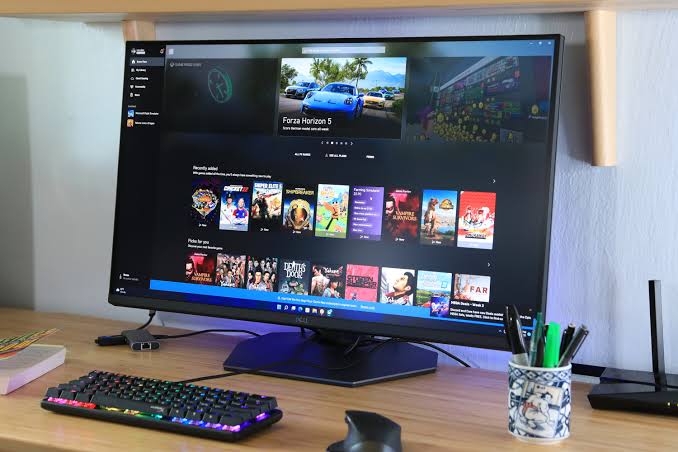In 2025, the gaming world is changing fast, and players want the best gear. A key part of any gaming setup is the monitor. A good gaming monitor improves your experience with clear pictures, quick response, and smooth play.
Choosing the perfect monitor involves more than just looking at size or brand. With an abundance of features, specifications, and technologies available, it’s essential to understand what each one means and how it impacts your gaming performance.
Determine Your Gaming Priorities
Before diving into specifications, you should first assess your gaming habits. Are you a competitive FPS gamer who needs high refresh rates and ultra-low latency? Or do you prefer immersive story-driven titles that benefit from rich visuals and color accuracy?
Casual gamers might prioritize comfort and affordability, while streamers and content creators may need a balance between gaming performance and color fidelity for editing. Understanding how you intend to use the monitor will narrow your options and prevent overspending on features you won’t use.
Screen Size and Resolution: Finding the Right Balance
The size of a monitor plays a major role in immersion and comfort. In 2025, gaming monitors commonly range from 24 inches to 34 inches or more. While larger screens provide a more immersive experience, especially in ultrawide formats, they also demand higher resolutions to maintain clarity.
Full HD (1920×1080) is still adequate for smaller screens, but for anything above 27 inches, 1440p (2560×1440) or 4K (3840×2160) is recommended. Higher resolutions deliver sharper images and allow for greater in-game detail, though they also require more powerful GPUs to maintain performance.
Refresh Rate and Response Time: Crucial for Competitive Play
Refresh rate refers to how many times per second the screen updates, measured in hertz (Hz). In 2025, 144Hz has become the standard baseline for competitive gamers, with 240Hz and 360Hz monitors becoming more accessible for serious players.
A higher refresh rate ensures smoother motion, reducing blur and making fast-paced action easier to follow. Paired with a low response time—typically 1ms for gaming monitors—these specs can provide a serious edge in games where milliseconds count.
If you primarily play fast-paced shooters like Call of Duty or Apex Legends, investing in a high refresh rate monitor is highly beneficial. For slower-paced games, such as RPGs or simulations, a 60Hz or 75Hz monitor might still suffice.
Panel Type: IPS vs VA vs OLED
The type of panel a monitor uses impacts color accuracy, contrast ratios, and viewing angles. The three main panel types in 2025 remain IPS, VA, and OLED.
IPS (In-Plane Switching) panels offer excellent color reproduction and wide viewing angles. They are ideal for users who also engage in content creation or value vibrant visuals. VA (Vertical Alignment) panels have superior contrast ratios, making them great for dark scenes, but they may suffer from slightly slower response times.
OLED monitors have gained more traction in 2025 due to their perfect blacks, vibrant colors, and ultra-fast response times. However, they remain more expensive and can be prone to burn-in if static images are displayed for long periods.
Your choice of panel should match your visual priorities and budget. IPS remains a safe middle ground, while OLED is ideal for premium builds focused on immersion.
Adaptive Sync: G-SYNC vs FreeSync
Screen tearing occurs when the frame rate output of your graphics card doesn’t match your monitor’s refresh rate. Adaptive sync technologies such as NVIDIA’s G-SYNC and AMD’s FreeSync help eliminate this problem by synchronizing the GPU and monitor.
In 2025, most gaming monitors support at least one of these technologies, and many now feature cross-compatibility. G-SYNC monitors are best paired with NVIDIA GPUs, while FreeSync works well with AMD cards.
For gamers using high-refresh monitors, adaptive sync is nearly essential. It ensures smoother gameplay and prevents visual artifacts without the input lag often introduced by traditional V-Sync settings.
Aspect Ratio and Curved vs Flat Monitors
Aspect ratio affects your field of view and overall immersion. The standard 16:9 ratio is still widely used, but ultrawide (21:9) and even super ultrawide (32:9) monitors are now more common among immersive gamers and multitaskers.
Curved monitors, especially in ultrawide formats, help create a more natural viewing experience by reducing distortion and eye strain. However, they require more desk space and can be overkill for casual users or those who play mostly competitive titles where central focus is more critical.
Flat monitors remain preferred for FPS gaming due to their predictable geometry, but curved screens are gaining popularity among sim racers and open-world RPG fans.
Connectivity and Ports Matter
Modern gaming monitors should offer a range of input options. In 2025, HDMI 2.1 and DisplayPort 2.1 are the most relevant standards. These interfaces support higher resolutions and refresh rates with reduced latency, which is crucial for next-gen consoles and high-performance PCs.
USB-C is also becoming a popular feature, especially for gamers using laptops or looking for a streamlined desk setup. Some monitors now include built-in KVM switches, allowing users to control multiple devices with a single keyboard and mouse.
Make sure the monitor you choose has the right ports to match your system. Compatibility with your GPU and peripherals will prevent unnecessary frustration and extra adapters.
HDR Performance and Color Accuracy
High Dynamic Range (HDR) improves color contrast and depth, providing a more visually rich experience. However, not all HDR is created equal. In 2025, true HDR gaming performance requires at least DisplayHDR 600 certification for noticeable improvements.
Monitors with lower-rated HDR often fall short of expectations due to limited brightness or inadequate contrast. If visual fidelity matters to you—especially for cinematic titles—invest in a monitor with strong HDR performance and wide color gamut coverage.
Creative users should also consider monitors with factory-calibrated color profiles and support for color spaces like sRGB, DCI-P3, or AdobeRGB.
Ergonomics and Build Quality
Comfort during long gaming sessions is often overlooked. In 2025, top monitors come with adjustable stands that offer tilt, swivel, height, and pivot options. This adjustability ensures better posture and reduces eye and neck strain.
Build quality also matters, especially if you plan to transport or mount the monitor. Look for durable materials, slim bezels, and cable management solutions that match your setup preferences.
Wall-mounting compatibility (VESA) is also useful for flexible desk arrangements, especially in multi-monitor setups.
Budget Considerations and Value for Money
Prices for gaming monitors vary widely depending on specs. Entry-level 1080p monitors with 144Hz can be found for under $200, while high-end OLED or ultrawide monitors can exceed $1,200.
Set a realistic budget based on your priorities. If you’re building a mid-range gaming setup, a 1440p IPS monitor with FreeSync and 144Hz might offer the best value. For elite performance, investing in 4K with high refresh and true HDR is now more viable than ever thanks to falling panel costs and competitive market options.
Research reviews, user feedback, and brand reputations before finalizing your choice.
Conclusion: Matching Tech to Your Needs
Choosing the perfect gaming monitor in 2025 isn’t about picking the most expensive model—it’s about understanding what matches your needs. Every feature, from refresh rate to panel type, plays a role in shaping your gaming experience.
Take time to evaluate your gaming style, hardware compatibility, and visual preferences. Whether you’re aiming for competitive edge or immersive storytelling, the right monitor can elevate your gameplay and bring your digital worlds to life.



